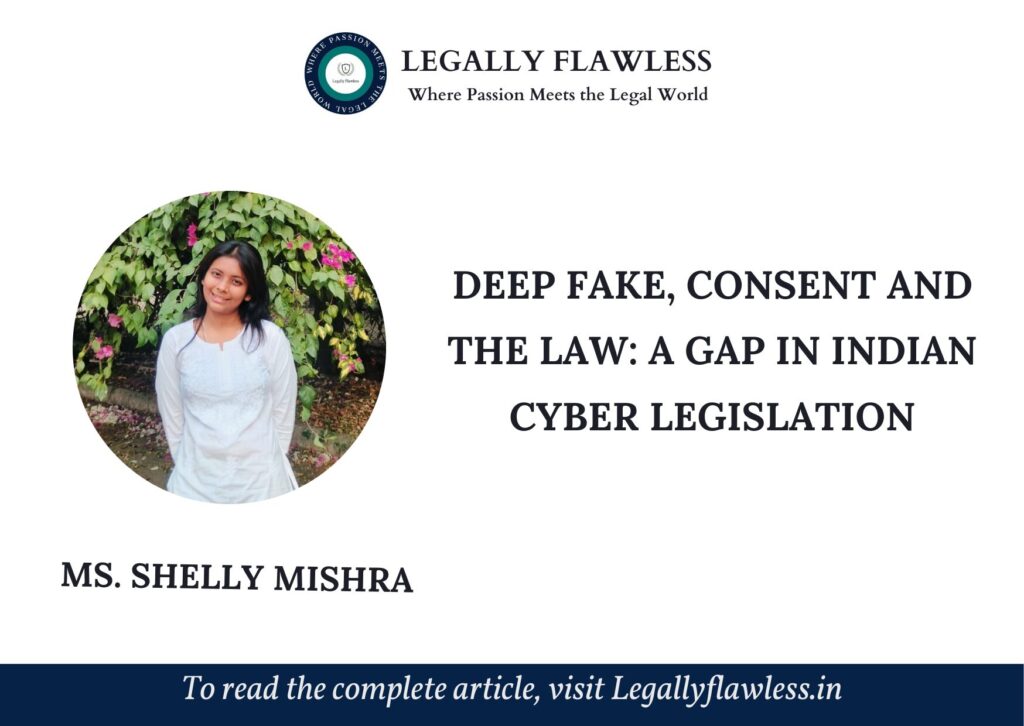
Table of Contents
Abstract
This article focuses on discussing an advanced form of artificial intelligence, known as “deep fake,” which generates information that is erroneously similar to authentic data, making the identification of inconsistency between the two nearly infeasible for users. The progress in technology poses a significant challenge to the field of cybersecurity. The primary objective of this article is to understand the concept of deep fakes and assess their impact on individual privacy, as well as the efficacy of existing legal frameworks in mitigating the associated risks.
Introduction
Deep fakes are artificial intelligence-generated media content, designed to make the general public believe the authenticity of the generated content as the first of its kind. Artificial intelligence (AI) generates images that differ from the original, involving a change in the person’s voice or accent, or a face swap, creating false pictures of actions that are supposed to be carried out by the actual people. Advancements in machine learning and artificial intelligence have enabled the alteration of images, videos, audio, and graphics to an extraordinary level. Models such as the Generative Adversarial Network (GAN) are used to create the deep fake content. this consists of two channels, one of which generates content and the other of which determines its accuracy. The system is effective in producing excellent fictional scenarios.
The consequences of this technology extend to various domains, like the capacity to generate highly realistic videos, raising concerns about the misuse of technology. This misuse constitutes a threat to society, as the propagation of untrue scenarios can harm the reputation of individuals, corporations, or nations. The core concern in this revolves around identity, as the easy exchange of identities with others through technological advancement, it negatively affects the credibility of information, spread social media platform, and create doubt on trustworthiness of news[1].
Type of Deep Fakes
- VIDEO DEEPFAKES: One of the most popular types of deep fakes is the substitution of another person’s face or body for the original, along with a change in the subject’s expression or body language, to produce realistic-looking artificial content. It mostly consists of face swapping, which allows one to easily read the expressions and facial movements of another.
- AUDIO DEEPFAKES: these includes the dubbing, cloning, conversion of person’s original voice, accent, speech pattern with the help of AI. This is typically connected with phone calls, public statements of celebrities, or any publicly available audio.
- IMAGE DEEPFAKES: These are photos that have been altered to change background details, facial expressions, or even the entire image. It can be completed using the standard features of a mobile phone and doesn’t require any additional work.
- MULTIMODAL DEEPFAKE: it consists of lip syncing and full body movement in a video or clip where the subject appears to say or act something with realistic facial expressions or body movements, along with other crucial components that give the impression that it was done by the subject themselves.
Effect of Deepfake
Deep fakes have created a significant problem for people’s privacy because they damage people’s reputations, sometimes irreparably. This is because they use artificial intelligence to create false audio, video, and image content. Additionally, it violates the principle of consent. Using publicly accessible videos, audios, etc., without the owner’s permission and authorization compromises privacy because, even if the deep fake is disproved, reputation harm cannot be restored because the internet rarely forgets and stores everything; such action can permanently damage a person’s name. When someone’s identity is altered without their consent and knowledge, it impacts their capacity to manage their online and offline activities, speech and image. Deep fake also puts people at risk of being exposed or the focus of needless attention on conversation, particularly for those who prefer to keep their lives private and out of the spotlight. Additionally, a person becomes the target of constant surveillance, which could result in inaccurate tracking or identification. Nowadays, almost all the information about a person is available online due to digitalization which enables the risk of identity theft. For instance, every government or private organization requires the unique identification number known as the “Aadhar card,” which is issued by the Indian government, as a link that is also a way to get basic information about an individual.[2]
Social Media’s role in deepfake
Due to its capacity to quickly and easily spread any information to a global audience in a matter of seconds, social media is vital in spreading the news of deep fake content. With little modification, it allows fake contents to reach a larger audience. There is so much fake content out there that it is hard to know the difference or find the source. It also makes it challenging to take down previously posted content, and social media apps do more to harm a person’s reputation. According to the way social media’s algorithm operates, content that has been viewed by a larger audience tends to trend and become readily accessible in other users’ feeds. Social media gives you a way to influence people by sharing news.[3]
Offence by deepfake
- VIRTUAL FAKES: Deep fakes have made it much simpler to fabricate a person or represent someone who does not exist. People can now be tricked, harassed, defamed, or financially cheated much more easily.
- HATE SPEECH AND MISINFORMATION: Hate speech and misinformation are two things that can bring down a government, government body, or organization. They can also provoke any unpleasant situation, such as riots, mob lynching’s, etc., by using deep fake information to spread inaccurate or incomplete information about them.
Spreading inaccurate or misleading information can disturb public confidence or be used to change public opinion, which can also lead to a sense of discontent with the government. Deep fakes can also be used to disseminate hate speech or defamatory content to hurt people’s feelings, which may eventually help to disturb the nation’s internal harmony.
- FAKE JUDICIAL PROCEEDINGS: False court proceedings are a risk as a result of the judicial and administrative systems’ adoption of technological advancements. People have been harassed by fictitious legal or judicial proceedings in a number of cases. People are being tried in false cases in the name of investigatory agencies such as the income tax department, customs department, etc., by fictitious courts that have been set up in a dishonest way. In order to make proceedings more effective, safe, and efficient, courts are using video conferencing in conjunction with online platforms, and they are now in used to deceive the general public.[4]
Legal Framework in India
India has many laws, but none specifically address deep fakes or offer solutions. While some current laws cover parts of the problem, there is a need for specific laws on artificial media. In India, some laws don’t directly deal with deep fakes but provide a basis to deal the issue. For example, the right to privacy, recognized in international agreements like the Universal Declaration of Human Rights (1948), places importance of personal privacy. This is reflected in Article 21 of the Indian Constitution, the Supreme Court in KS Puttaswamy vs Union of India [5]states that privacy includes controlling the spread of personal information. Also, the Digital Personal Data Protection Act of 2023 [6] addresses the regulation of digital personal data in India, which includes both online and offline data. Personal data can only be processed with the individual’s consent for legitimate purposes. The act grants individuals’ rights, including access to their data, the ability to request corrections and deletions, and the option to file complaints. The central government can exempt certain agencies from specific provisions of the Bill for reasons like national security, public order, and crime prevention. Additionally, the government will establish the Data Protection Board of India to comply with the regulations of the act.
The government’s intermediary Guidelines and Digital Media Ethics Code Rules, 2021, focus on social media platforms, requiring them to reveal user identities when the government asks and to take responsibility for user content. Moreover, Indian criminal laws punish fraud, including identity theft and virtual forgery via deep fakes, which can seriously affect individuals and society.
The Information Technology Act 2000 [7]provides several sections addressing misuse of computer resources and digital content. Section 66D imposes penalties for committing fraud by impersonation via computers, with potential sentences of up to 3 years and fines reaching 1 lakh rupees. Section 66E deals with privacy violations, specifically the unauthorized sharing or publishing of private images, resulting in a fine 2 lakh rupees, imprisonment for 3 years, or both. This section also covers the use of computers to deceive or impersonate others with harmful intent.
Section 66F addresses cyber terrorism, including misinformation that may incite hatred towards the government, damage public trust, or provoke terror and violence. Section 79 allows social media platforms to remove deep fake content when notified or ordered by a court. These platforms may not be held liable if they do not initiate, select recipients, or modify the transmitted information, as long as they act responsibly.
The basis for copyright protection in India is set by the Indian Copyright Act of 1957 and the Copyright Rules of 1958. Section 2(y) of the act defines ‘work[8]‘ to include various types such as drawings, engravings, photos, literature, computer compilations, musical etc. It punishes on misuse of others’ creative work used to create misleading content or spread false information. Section 51 specifically deals with copyright infringement and penalizes for certain violations.[9]
Section 353 of BNS addresses public mischief, punishes those who knowingly spread false information, rumours, or reports by any means, including electronic media, that cause public fear, or promote differences between groups. Section 356 covers defamation, stating that anyone who harms another’s reputation through spoken or written words with harmful intent is guilty and can be punished. Deep fakes fall under defamation because they spread false content that people would not support, damaging their public image. Section 318 defines cheating as deceiving someone dishonestly or fraudulently without their consent, which is also punishable. [10]
Suggestions
- The most crucial step in addressing the deep fake is creating a suitable, flexible legal framework that addresses nearly every aspect of the related offences and unfair practices associated with it and has appropriate and efficient penal provisions to address any potential offence. Also, it is necessary to pass laws that mandate online platforms to promptly act, detect, and remove fake content using moderation algorithms and digital watermarking.
- Apart from laws, technological tools are required to verify online content, especially on social media. Using technology to spot deep fakes before they spread on social media platforms is a proactive strategy. Governments can fund research to develop tools that detect and combat deep fakes. Government agencies can collaborate with the technology industry and content validation standards, and promote the use of deep fake detection.
- The general public should be made aware of the dangers of deep fakes, and media literacy should be encouraged. The government should start awareness campaigns using advertisements, mass media, and any other means to raise awareness. Verifying the content before uploading any sensitive information is crucial to ensure consistency and avoid spread of false information.[11]
Conclusion
Availability of artificial intelligence is a critical area having both opportunities and threats to the modern era, with flaws in the legal, ethical, and social spheres. Despite its many benefits, deep fakes are highly deceptive and complicated technologically. High-level artificial intelligence (AI) such as GAN, which creates realistic synthetic media content, has drawn attention to appropriate legal regulation aimed at deep fake misuse and the detection of false media content through the application of cutting-edge technological solutions.
An appropriate legal framework with competent and efficient enforcement agencies is therefore necessary to address the risk of deep fakes. Strict legislation, technological development, and public awareness are all part of a comprehensive strategy to eliminate the risk associated with deep fakes.
This article is authored by Ms. Shelly Mishra, student at Banasthali Vidyapith University.
[1] Aditya Pratap Singh, Legal Implications of Deepfake Technology in Criminal Law, 8 Int’l J. L. Mgmt. & Human. 1645 (2025), https://ijlmh.com/wp-content/uploads/Legal-Implications-of-Deepfake-Technology-in-Criminal-Law.pdf.
[2] Decoding Consent in the Age of Deep Fakes: A Legal Vacuum in India’s Cyber Law, Madhav Univ. Blog (Apr. 28, 2025), https://blog.madhavuniversity.edu.in/decoding-consent-in-the-age-of-deep-fakes-a-legal-vacuum-in-indias-cyber-law/
[3] Meera Srikant, Bharatiya Laws Against Deepfake Cybercrime: Opportunities and Challenges, Vivekananda Int’l Found. (Apr. 28, 2025), https://www.vifindia.org/article/2025/april/28/Bharatiya-Laws-Against-Deepfake-Cybercrime-Opportunities-and-Challenges.
[4] Legal Challenges of Deepfake Technology and AI-Generated Content in India, Jus Corpus (Apr. 21, 2025), https://www.juscorpus.com/legal-challenges-of-deepfake-technology-and-ai-generated-content-in-india/.
[5] (2017) 10 SCC 1
[6] PRS Legislative Research, The Digital Personal Data Protection Bill, 2023, https://prsindia.org/billtrack/digital-personal-data-protection-bill-2023
[7] ClearTax, IT Act 2000: Objectives, Features, Amendments, Sections, Offences, https://cleartax.in/s/it-act-2000 (last visited May 22, 2025).
[8]Section 2 (y) of copyright act 1957 “work” means any of the following works, namely:— (i) a literary, dramatic, musical or artistic work; (ii) a cinematograph film; (iii) a 2 [sound recording];
[9] Vishakha Periwal, Deepfake Laws in India: A Critical Analysis, 7 Int’l J. for Multidisciplinary Res. 1 (2025), https://www.ijfmr.com.
[10] Ministry of Law & Justice, The Bharatiya Nyaya Sanhita, 2023, No. 45 of 2023, https://www.mha.gov.in/sites/default/files/250883_english_01042024.pdf
[11] Aditya Pratap Singh, Legal Implications of Deepfake Technology in Criminal Law, 8 Int’l J. L. Mgmt. & Human. 1645 (2025), https://ijlmh.com/wp-content/uploads/Legal-Implications-of-Deepfake-Technology-in-Criminal-Law.pdf.IJLHM+1
All efforts are made to ensure the accuracy and correctness of the information published at Legally Flawless. However, Legally Flawless shall not be responsible for any errors caused due to oversight or otherwise. The users are advised to check the information themselves.


